AMD Kaveri Review: A8-7600 and A10-7850K Tested
by Ian Cutress & Rahul Garg on January 14, 2014 8:00 AM ESTIntegrated GPU Performance: BioShock Infinite
The first benchmark in our test is Bioshock Infinite, Zero Punctuation’s Game of the Year for 2013. Bioshock Infinite uses the Unreal Engine 3, and is designed to scale with both cores and graphical prowess. We test the benchmark using the Adrenaline benchmark tool and their three default settings of Performance (1280x1024, Low), Quality (1680x1050, Medium/High) and Xtreme (1920x1080, Maximum) noting down the average frame rates and the minimum frame rates.
Bioshock Infinite, Performance Settings
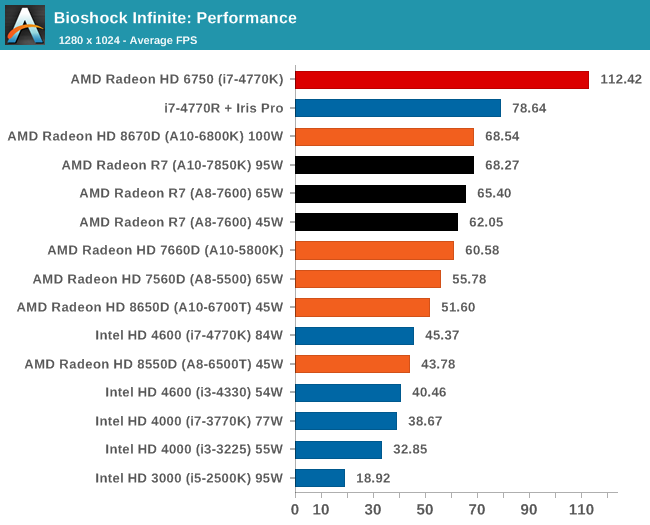
For BI: Performance we see the Iris Pro being top of the IGPs, although the next six in the list are all AMD. The Kaveri cores are all between the 6800K and 5800K for this test, and all comfortably above 60 FPS average.
Bioshock Infinite, Quality Settings

For the quality settings, the Iris Pro starts to struggle and all the R7 based Kaveri APUs jump ahead of the A10-6800K - the top two over the Iris Pro as well.
Bioshock Infinite, Xtreme Settings
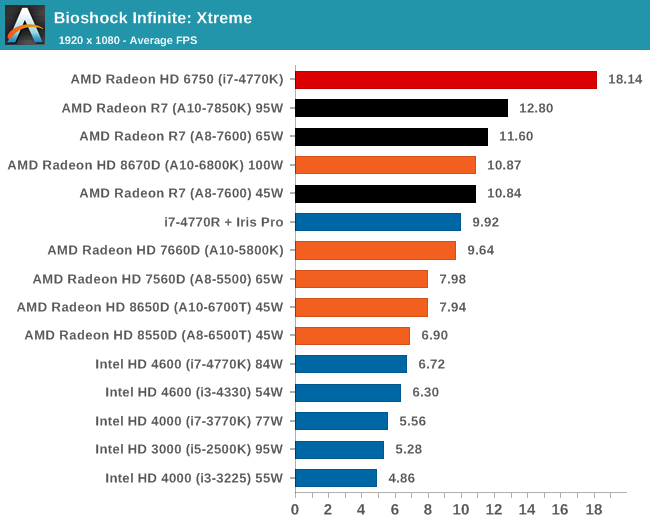
The bigger the resolution, the more the Iris Pro suffers, and Kaveri takes three out of the top four IGP results.
Integrated GPU Performance: Tomb Raider
The second benchmark in our test is Tomb Raider. Tomb Raider is an AMD optimized game, lauded for its use of TressFX creating dynamic hair to increase the immersion in game. Tomb Raider uses a modified version of the Crystal Engine, and enjoys raw horsepower. We test the benchmark using the Adrenaline benchmark tool and their three default settings of Performance (1280x1024, Low), Quality (1680x1050, Medium/High) and Xtreme (1920x1080, Maximum) noting down the average frame rates and the minimum frame rates.
Tomb Raider, Performance Settings
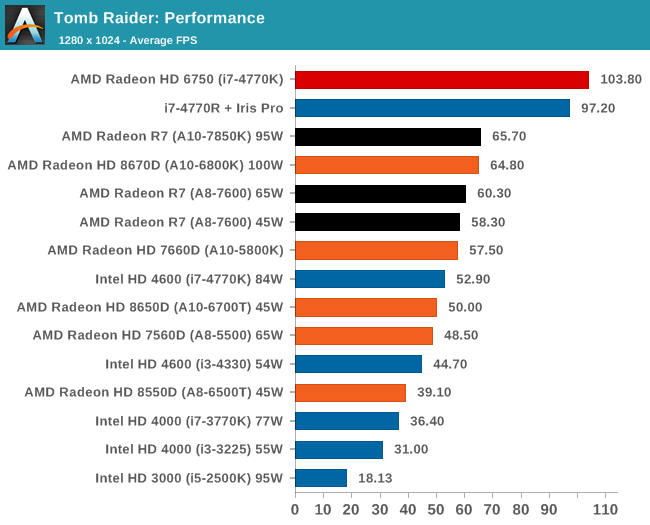
The top IGP for Richland and Kaveri are trading blows in TR.
Tomb Raider, Quality Settings

The Iris Pro takes a small lead, while the Kaveri 95W APU show little improvement over Richland. The 45W APU however is pushing ahead.
Tomb Raider, Xtreme Settings
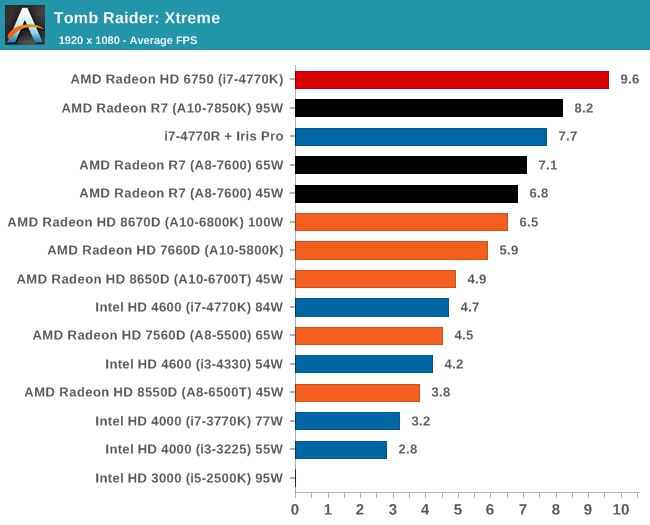
At the maximum resolution, the top Kaveri overtakes Iris Pro, and the 45W Kaveri it still a good margin ahead of the A10-6700T.
Integrated GPU Performance: F1 2013
Next up is F1 2013 by Codemasters. I am a big Formula 1 fan in my spare time, and nothing makes me happier than carving up the field in a Caterham, waving to the Red Bulls as I drive by (because I play on easy and take shortcuts). F1 2013 uses the EGO Engine, and like other Codemasters games ends up being very playable on old hardware quite easily. In order to beef up the benchmark a bit, we devised the following scenario for the benchmark mode: one lap of Spa-Francorchamps in the heavy wet, the benchmark follows Jenson Button in the McLaren who starts on the grid in 22nd place, with the field made up of 11 Williams cars, 5 Marussia and 5 Caterham in that order. This puts emphasis on the CPU to handle the AI in the wet, and allows for a good amount of overtaking during the automated benchmark. We test at three different levels again: 1280x1024 on Low, 1680x1050 on Medium and 1920x1080 on Ultra. Unfortunately due to various circumstances we do not have Iris Pro data for F1 2013.
F1 2013, Performance Settings
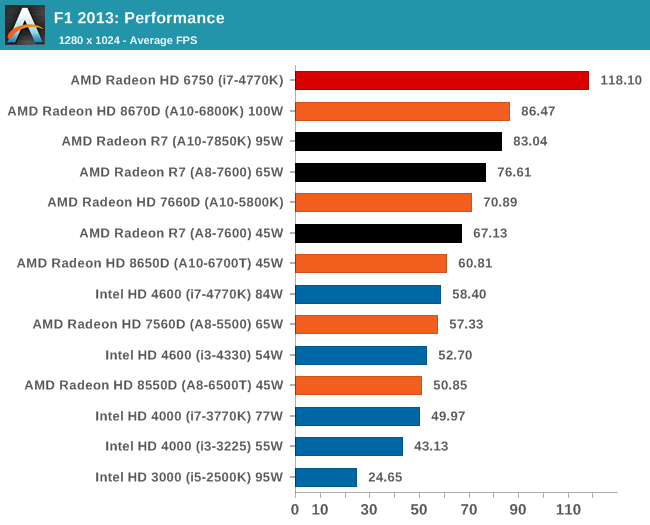
F1 likes AMD here, although moving from Kaveri to Richland at the high end seems a bit of a regression.
F1 2013, Quality Settings
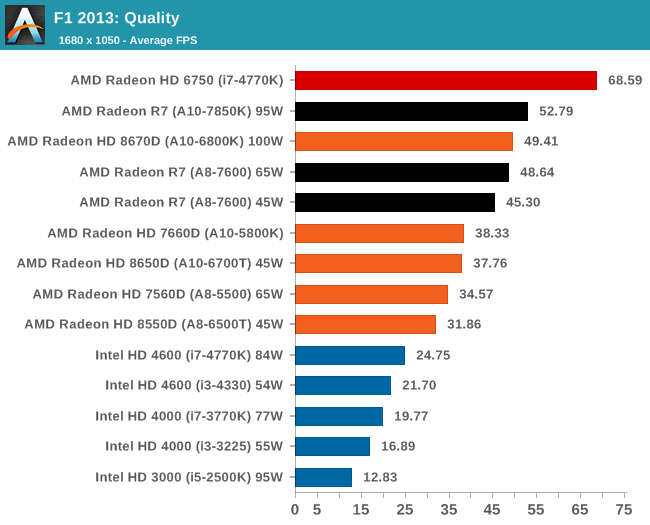
Similarly in the Quality settings, none of the Intel integrated graphics solutions can keep up with AMD, especially Kaveri.
F1 2013, Xtreme Settings

On extreme settings, at 1080p, the top Kaveri APU manages to hit over 30 FPS average during the benchmark. The other A8 Kaveri data is not too far behind.










380 Comments
View All Comments
fteoath64 - Sunday, January 19, 2014 - link
"Now we need a new one, a fully HSA compliant HyperTransport." Yes! The dedicated people working on new SuperComputers are doing exotic Interconnects close or exceeding 1TBytes/sec speeds but limited by distance naturally. I see that for HyperTransport 3.0 one can implement 10 channels for high aggregated bandwidth, but that will use more transistors. In a budget conscious die size, using eSRAM seems to be a good trick to boost the bandwidth without overt complexity or transistor budget. The downside is eSRAM suck constant power so it becomes a fixture in the TDP numbers. Iris PRO uses 128MB of eDRAM while Xbox One uses 32MB eSRAM. I think the least amount would be somewhere around 24MB for the x86 to be effective in getting effective RAM bandwidth high enough!.The cascading effect if that the memory controller becomes complex and eats into the transistor budget considerably. Seems like a series of moving compromises to get the required performance numbers vs power budget for TDP.
I am actually very excited to see an Arm chip implementing HSA!!.
Samus - Wednesday, January 15, 2014 - link
I don't get why AMD can't compete with Intel's compute performance like they were absolutely able to do a decade ago. Have they lost all their engineering talent? This isn't just a matter of the Intel manufacturing/fab advantage.zodiacfml - Wednesday, January 15, 2014 - link
oh no, after all that, I just came impressed with the Iris Pro. I believe memory bandwidth is needed for Kaveri to stretch its legs.duploxxx - Wednesday, January 15, 2014 - link
impressed with iris pro? for that price difference i would buy a mediocore CPU and dedicated GPU and run circles around it with any game....oaf_king - Wednesday, January 15, 2014 - link
I can point out some carpola here: "I am not sure if this is an effect of the platform or the motherboard, but it will be something to inspect in our motherboard reviews going forward." This sure discounts the major performance benefits you can achieve without faulty hardware. Search the real benchmarks on WCCF tech for A-10 7850 and be amazed. I can STRONGLY DOUBT the CPU has any issue running at 4ghz on a stock cooler/900mhz GPU. Yes the GPU overclock seems skipped over in this Anand review also, but should really pull it into the "useful" category for gaming!oaf_king - Wednesday, January 15, 2014 - link
recall AMD had some leaks suggesting 4ghz CPU / 900Mhz GPU. Is that possible after all? Apparently not all motherboards are faulty. If the TDP tops out at 148 at 4ghz, given the conservative power envelopes already placed on the chip, I'm sure it gets very good performance for between zero and ten extra dollars, and a couple seconds in the BIOS.Fox McCloud - Wednesday, January 15, 2014 - link
Maybe I was skim reading and missed it, but what are the idle power consumption figures for the A8-7600? I need a new home server and I have a iTX system, and mother boards with 6x SATA are slim. It seems the manufacturers only put them on AMD ITX boards, as Intel seem to max out at like 4. I wonder what power figures would be like if under clocked also. I might re-read the review!Excellent review as always guys. So in-depth, informative, technical and unbiased. This is why I love this site and trust your expert opinion :)
Zingam - Wednesday, January 15, 2014 - link
AMDs PR: "The processor that your grandparents dream of!" FYEAHA!keveazy - Wednesday, January 15, 2014 - link
My i5 4440 costs the same as the a10-7850k. I don't think amd will ever compete. By the time they release something that would declare a significant jump, Intel would already have something new to destroy it by then.duploxxx - Wednesday, January 15, 2014 - link
compete to do what? general tasks in a day, just buy an SSD... cost? did check your motherboard price? GPU, did you check the 4600 performance vs a10? it runs circles around it unless you want to be stuck on low resolution with your gorgeous fast cpu.you see customers fool themselve not knowing what to buy for what. hey i have the best benchmarking cpu, but on daily tasks i can't even count the microseconds difference.